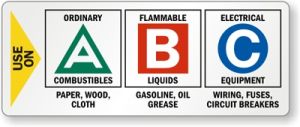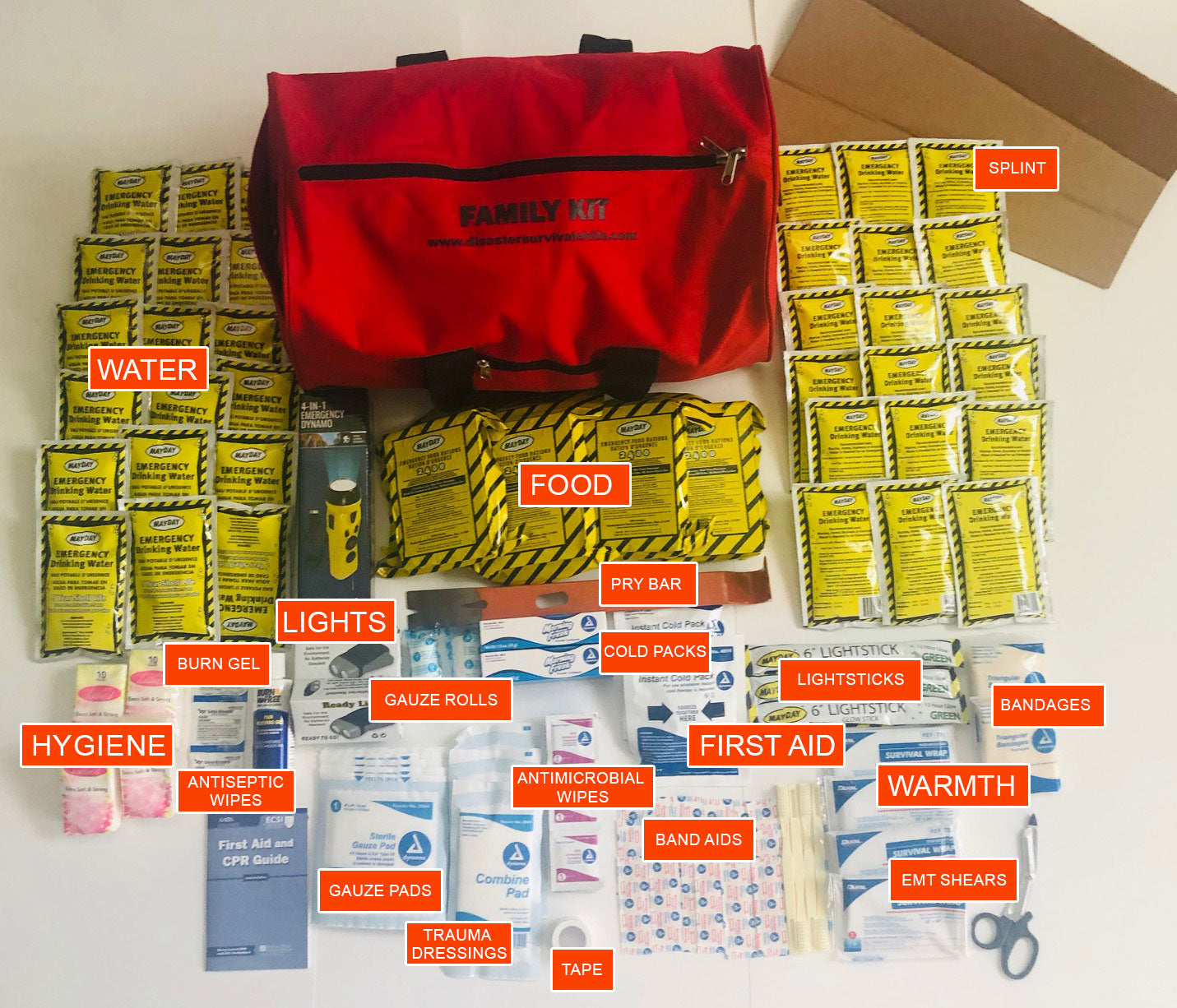Earthquakes can come without warning, leaving you and your family feeling vulnerable and unprepared. But if you’re prepared with a survival kit, these disasters can be better managed. A survival kit is an essential tool for any family to have in their home, especially those located in seismically active areas. It should contain items that are necessary for basic needs such as drinking water and food, as well as items that will come in handy during times of natural disaster. In this blog post, we’ll cover the top five essential items to include in your survival kit so that you can keep your family safe during an earthquake.
Your First Aid Kit
A well-stocked first aid kit is a necessity in any home. You never know when someone will need it, so it's important to be prepared. Here are some essential items that should be in your first aid kit:
- Bandages: Include a variety of sizes and types, such as gauze pads, adhesive bandages, and ace wraps.
- Antiseptic wipes: Used to clean cuts and scrapes before applying a bandage.
- Tweezers: Ideal for removing splinters or other small objects from wounds.
- Scissors: Needed for cutting bandages and tape.
- Pain relievers: Include over-the-counter options like ibuprofen and acetaminophen.
- Antihistamines: Helpful for dealing with allergic reactions or bug bites.
- Burn cream: For treating minor burns.
- Hydrocortisone cream: Relieves itching from insect bites or rashes.
Fire Extinguisher
A fire extinguisher is one of the most important items to have in your earthquake survival kit. In the event of an earthquake, a fire is one of the most likely dangers you will face. Having a fire extinguisher on hand will help you put out any fires that may start, keeping you and your family safe.
There are many different types of fire extinguishers available on the market, but for earthquake survival, you want one that is rated for Class A, B, and C fires. Class A extinguishers are designed for ordinary combustibles such as wood and paper; Class B extinguishers are for flammable liquids such as gasoline and oil; and Class C extinguishers are for electrical fires. Fire extinguishers are usually labeled with their class rating, so be sure to choose one that covers all three types of fires.

When choosing a fire extinguisher, also consider its size and weight. You want an extinguisher that is large enough to put out a significant fire, but not so large or heavy that it will be difficult to carry or use in an emergency situation.
Utility Shutoff Tool
If an earthquake hits, one of the first things you'll want to do is shut off utilities like gas and water. But if the shaking is too strong, it can be hard to do this safely. That's why it's a good idea to have a utility shutoff tool in your survival kit.
This tool is designed to help you quickly and easily shut off these utilities. It's easy to use, even in a dark or cramped space. And it's small enough to keep in your pocket or pack, so you're always prepared.
In an emergency, every second counts. So make sure you have a utility shutoff tool in your survival kit, and be ready for anything.
Water
One of the most important things you can do to prepare for an earthquake is to have a reliable source of water. In the event of a major earthquake, tap water may not be available, so it's important to have water stored in a safe, easily accessible place. Here are some tips for storing water:
- Store at least 1 gallon of water per person, per day.
- If possible, store more than 1 gallon per person, especially if you live in a hot climate or have young children or elderly family members.
- Store water in clean, food-grade containers. Glass jars and plastic bottles are both good options. Avoid using old milk jugs or other containers that could leach chemicals into the water.
- Label your containers with the date they were filled, so you know how long they'll last. Water can be stored for up to 6 months before it needs to be replaced.
- Keep your stored water in a cool, dark place. A closet or pantry is ideal.
Light

If an earthquake hits, one of the first things you'll want to do is find a safe place. Once you're in a safe place, it's important to have a source of light. A flashlight is a good option, but if you don't have one, you can use a candle or even your phone as a source of light.
It's also important to have a way to signal for help. A whistle or a light sticks can be used to get help.
Food

When an earthquake strikes, it's important to have a survival kit on hand to help you and your family stay safe. Here are some essential items to include in your kit:
- Food: Non-perishable food items like canned goods, dry cereal, and granola bars are essential. If you have infants or small children, include formula or baby food as well.
- Water: At least one gallon of water per person, per day is recommended. Fill up clean containers now so you'll have plenty on hand in case of an emergency.
- First Aid Kit: A basic first aid kit should include bandages, gauze, antibiotic ointment, and pain relievers. Add any other items you think you might need based on your family's medical needs.
- Flashlight and Batteries: A flashlight can be used for signaling for help or for providing light during a power outage. Be sure to pack extra batteries as well.
- Weather Radio: A battery-operated weather radio can keep you informed of conditions after an earthquake and let you know when it is safe to leave your shelter.
Shelter & Sanitation

When an earthquake hits, the first priority is to find shelter and stay safe. To do this, you need to have a plan in place ahead of time. Here are some essential items that will keep your family safe in an earthquake:
- A sturdy shelter: This could be a reinforced concrete structure or a heavy-duty tent. Make sure it is large enough to comfortably fit your entire family and all of your survival gear.
- Sanitation supplies: Water is critical for survival, so make sure you have plenty of stored water as well as filters or purification tablets. You will also need a way to dispose of human waste properly. A portable toilet and/or tarp can be used for this purpose.
- Non-perishable food and water: Stock up on canned food, dried fruits and nuts, energy bars, etc. that will last for at least a week. Store water in clean, airtight containers and rotate it every 6 months so it stays fresh.
- First aid kit: This should include basics like bandages, gauze, antiseptic cream, pain relievers, etc. Be sure to customize it according to the specific needs of your family members (e.g. allergies, chronic illnesses).
- Flashlights and batteries: Keep several flashlights handy, as well as extra batteries in case of power outages following an earthquake. Candles are also useful but be sure to use
Car Survival Kit
A car survival kit is a must for any family living in an earthquake-prone area. Here are the top essential items that will keep your family safe in an event of a quake:
- A sturdy pair of shoes - In the event of an earthquake, you may have to walk long distances or even climb over debris. A good pair of shoes will protect your feet and help you move more quickly.
- A flashlight - Power outages are common after earthquakes, so a flashlight is essential. Choose one that is bright and has long battery life.
- Bottled water - It's important to stay hydrated during and after an earthquake, especially if you are involved in rescue efforts. Pack enough water for each person in your family for at least three days.
- Non-perishable food - Again, power outages are common after earthquakes, so having non-perishable food on hand is crucial. Canned food, energy bars, and other shelf-stable items are ideal.
- First aid kit - A well-stocked first aid kit is always a good idea to have on hand, but it's especially important after an earthquake when injuries are likely. Be sure to include plenty of bandages, gauze, and antiseptic wipes or cream.
Pet Survival Kit
A pet survival kit is a must for any pet owner in an earthquake-prone area. Just like a human survival kit, a pet survival kit should contain food, water, and other essential items to keep your pet safe and healthy in the event of a disaster.
Here are some essential items to include in your pet survival kit:
- Enough food and water for at least three days
- A bowl or container for food and water
- A leash or harness
- A carrier or crate (if your pet is small enough to fit inside)
- A toy or two to help keep your pet occupied and calm
- Any medications your pet takes on a regular basis
- First aid supplies, including gauze, bandages, antiseptic wipes, and hydrogen peroxide (to clean wounds)
By having a pet survival kit on hand, you can rest assured that you're prepared for anything and that your beloved furry friend will be taken care of in the event of an emergency.
Conclusion
Building a family survival kit is essential for earthquake preparedness. With the right items, you can ensure that your family stays safe and able to cope with whatever comes their way during an earthquake. From food and water, to medical supplies and communication devices, these five essential items will help keep your family safe if disaster strikes. Remember; always be prepared – it could make all the difference!
Introducing the Free Family Disaster Survival Calculator
The Family Disaster Survival Calculator is an online tool designed by Capt. Wayne Bennett (Ret.) to help families prepare for emergencies and disasters. The calculator will generate a personalized report that outlines the steps you can take to prepare your family for emergencies. This may include recommendations for creating an emergency kit, developing a family communication plan, and identifying evacuation routes or safe areas in your home.




